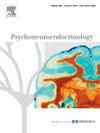Diurnal cortisol profiles and subjective well-being: Longitudinal associations among children and adolescents
IF 3.6
2区 医学
Q2 ENDOCRINOLOGY & METABOLISM
引用次数: 0
Abstract
There has been evidence suggesting that cortisol is related to subjective well-being. (i.e., positive affect, negative affect, life satisfaction). However, longitudinal associations between diurnal cortisol and subjective well-being remain inadequately explored, and less is known about how combinations of multiple diurnal cortisol indicators may impact subjective well-being. To address these gaps, the current study revealed heterogeneity in diurnal cortisol patterns and examined whether these diurnal cortisol patterns were prospectively associated with subjective well-being six months and one year later among 304 Chinese children and adolescents aged 9–13 (Mage = 10.80, SD = 0.84; 67.1 % boys). Latent profile analysis, a person-centered approach, was conducted using multiple diurnal cortisol indicators (i.e., waking cortisol level, cortisol awakening response, diurnal cortisol slope, area under the curve, and bedtime cortisol level), and identified four distinct diurnal cortisol patterns: steep/medium (57.6 %), moderate/high (25.7 %), flat/high (10.5 %), and steep/low (6.2 %). The flat/high pattern, characterized by sustained elevated cortisol levels throughout the day, was associated with impaired subjective well-being six months and one year later. The moderate/high pattern, which had the same waking cortisol level as the flat/high pattern but demonstrated lower cortisol awakening response and steeper diurnal cortisol slope, was associated with more negative affect six months later. These findings facilitate understanding the heterogeneity in diurnal cortisol rhythm and their implications to subjective well-being over time, which may support targeted psychosocial interventions for promoting subjective well-being among children and adolescents.
皮质醇日谱和主观幸福感:儿童和青少年的纵向关联
有证据表明,皮质醇与主观幸福感有关。(即积极影响,消极影响,生活满意度)。然而,日皮质醇与主观幸福感之间的纵向关联仍然没有得到充分的探索,并且对多个日皮质醇指标的组合如何影响主观幸福感的了解较少。为了解决这些差距,本研究揭示了皮质醇日模式的异质性,并研究了304名9-13岁的中国儿童和青少年的皮质醇日模式是否与6个月和1年后的主观幸福感相关(Mage = 10.80, SD = 0.84;67.1 %男孩)。以人为中心的潜在剖面分析使用多个皮质醇日指标(即清醒皮质醇水平、皮质醇觉醒反应、皮质醇日斜率、曲线下面积和就寝皮质醇水平)进行,并确定了四种不同的皮质醇日模式:陡峭/中等(57.6 %)、中等/高(25.7 %)、平缓/高(10.5 %)和陡峭/低(6.2 %)。以全天持续升高的皮质醇水平为特征的平/高模式与六个月和一年后主观幸福感受损有关。中/高模式与平/高模式具有相同的清醒皮质醇水平,但表现出较低的皮质醇觉醒反应和更陡峭的皮质醇日斜率,六个月后与更多的负面影响相关。这些发现有助于理解皮质醇昼夜节律的异质性及其随时间推移对主观幸福感的影响,这可能支持有针对性的社会心理干预,以促进儿童和青少年的主观幸福感。
本文章由计算机程序翻译,如有差异,请以英文原文为准。
求助全文
约1分钟内获得全文
求助全文
来源期刊

Psychoneuroendocrinology
医学-精神病学
CiteScore
7.40
自引率
8.10%
发文量
268
审稿时长
66 days
期刊介绍:
Psychoneuroendocrinology publishes papers dealing with the interrelated disciplines of psychology, neurobiology, endocrinology, immunology, neurology, and psychiatry, with an emphasis on multidisciplinary studies aiming at integrating these disciplines in terms of either basic research or clinical implications. One of the main goals is to understand how a variety of psychobiological factors interact in the expression of the stress response as it relates to the development and/or maintenance of neuropsychiatric illnesses.
 求助内容:
求助内容: 应助结果提醒方式:
应助结果提醒方式:


